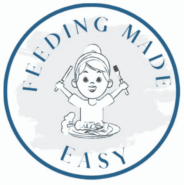Do you find yourself constantly cleaning up the floor after every meal? Has mealtime become a game where your toddler tosses food down just for you to pick it up again? If so, know that you’re not alone. Food throwing is a common issue plaguing many parents.
This post may contain affiliate links and when you click on the links I may earn a small commission at no charge to you. As an Amazon affiliate, I earn a commission from qualifying purchases.
Figure Out the Why
The first step to stopping food throwing is figuring out why your child is doing it in the first place.
If your child is very young, it may be a coordination problem. Bringing food to the face is a skill that takes practice. Food hitting the floor may just mean they need more practice.
If your child is older, there can be a couple of reasons why they are throwing food:
- They don’t like the food and don’t know where to put it.
- It’s become a fun game.
- They’re done eating and this is how they are telling you.
- They’re uncomfortable.
- They’re bored.
Once you figure out the why, you can figure out which tips will be the most helpful for you.
Your Child is Young
If your child is very young, the best thing you can do is give them more practice. This can be at mealtimes or you can give them other activities that will work on similar coordination skills. These can be any activities that require your child to use both their hands to complete a task.
Until your child gains coordination, focus on making cleanup easier. You can try using a messy mat under the table to help with quicker clean ups.
Your Child Doesn’t Like the Food
Consider using a no-thank-you bowl. This is a bowl (or plate) that you put out that your child can move any food they don’t want into. It gives them a very clear place to put food they don’t want. A bowl tends to work better than a plate for many kids, because the higher walls make the unwanted food less visible.
For some kids, the idea of the no thank you bowl may become more of a game where the child wants to move the food back and forth between their plate and the no thank you bowl. While this does count as exposure to the food, it may not be ideal for meal time. You may want to remove the no thank you bowl in these instances.
Food Throwing is a Game
When your child drops food, do you immediately pick it up? Or do you give a big reaction telling them to stop throwing food? If so, they may look at it like a fun game. In these cases, you may want to lay down a messy mat to protect your floor and then let your child drop food and just ignore it.
I realize that having food left on the floor is not ideal, but often when you ignore a behavior like this, it goes away on its own. When you make it a big deal, it becomes more fun for your child.
They Finished Their Meal
Your child may be throwing their food to tell you they’re done eating. If your child is on the younger end, you can teach them simple signs for words like “all done.” This will help them better communicate with you. If your child is older, you can teach them the phrases you prefer them to use: “when you’re all done, instead of throwing your food, ask to be excused and we can put your plate in the sink.”
They’re Uncomfortable
If you haven’t given much thought to your child’s seating situation during meal times, your child may be uncomfortable sitting at the table. Make sure that you’ve chosen an appropriate high chair or booster seat. If your child is past that age, you can create a make shift foot rest with exercise bands which can help with comfort and give your child something to fidget with during the meal. Food throwing is one way that kids may act out when they are uncomfortable.
They’re Bored
Depending on how long your meal times last, your child may just be bored. Kids do not have long attention spans and they may be pushed past their limits during meal time. A good rule of thumb is 2-5 minutes/year of age. If your meals are lasting much longer than that, you may want to consider excusing your child sooner or not inviting your child until the food is actually ready for them to eat. You can slowly increase the amount of time your child stays at the table over time.
When in Doubt: Model
If you’re unsure why your child is doing the behavior, the best course of action is to model the desired behavior. That’s one of the benefits of family meals: we can show our kids exactly how we want them to behave at meal time. You don’t need to go out of your way to show these behaviors, just don’t throw your food and show your child what to do instead!
Want to learn more about feeding toddlers? Check out my Toddler Feeding 101 Book!

Krystyn Parks is a Registered Dietitian and Lactation Consultant who specializes in feeding children. She has a Master’s Degree in Nutritional Science from California State University Long Beach. She is an International Board Certified Lactation Consultant and has been registered with the Commission on Dietetic Registration since 2013.
